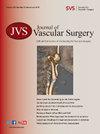Long-term outcomes of radiocephalic arteriovenous fistulas created in anatomical snuffbox or with VasQ external support device
IF 3.9
2区 医学
Q1 PERIPHERAL VASCULAR DISEASE
引用次数: 0
Abstract
Objective
This study evaluates the long-term outcomes of radiocephalic arteriovenous fistulas (RCAVFs) created in the anatomical snuffbox (SB-AVF) or with the VasQ external support device (ES-RCAVF).
Methods
We conducted a single-center retrospective analysis including 394 primary AVFs created for hemodialysis access in patients with advanced kidney disease between November 2017 and October 2024. Outcomes examined included rates of access maturation, successful cannulation, patency (primary, assisted primary, and secondary), reintervention rates, and rates of juxta-anastomotic stenosis. Multivariate analyses were used to study the associations between baseline characteristics and clinical outcomes, aiming to identify variables that could inform algorithmic decision-making for optimal distal RCAVF configuration selection.
Results
The cohort consisted of 148 SB-AVFs and 246 ES-RCAVFs. ES-RCAVFs had significantly higher rates of 4-week maturation (81.9% vs 69.7%; P = .009), successful cannulation (82.6% vs 71.6%; P = .044), and tunneled dialysis catheter (TDC) removal (62.9% vs 56.9%; P = .28) at 6 months as compared with SB-AVFs. There was no significant difference in juxta-anastomotic stenosis rates (34% in the SB-group and 32% in the ES-group; P = .734) or 5-year patency rates between the two groups (26.1% vs 26.6% for primary [P = .531]; 51.2% vs 52.4% for assisted primary [P = .778]; and 56.5% vs 57.8% for secondary [P = .1278] patency rates) for the SB-AVF vs ES-RCAVFs, respectively. The number of interventions per patient year was 0.46 for SB-AVFs and 0.57 for ES-RCAVFs (P = .998). In the multivariate analysis, the VasQ significantly (P = .001) increased the probability of maturation, and female gender (P = .007) and diabetes (P = .026) significantly reduced that probability at 4 weeks. The VasQ also significantly increased the probability of overall maturation (P = .002). Female gender (P = .003) and older age (P = .028) negatively contributed to the probability of overall maturation. Moreover, VasQ significantly increased the probability of cannulation success (P = .034) and was the only significant factor for increased likelihood of TDC removal by 6 months (P = .031). Female gender (P = .002) and older age (P = .006) were associated with a significantly decreased likelihood of TDC removal.
Conclusions
Our findings indicated that, although ES-RCAVFs achieve superior short-term and long-term outcomes, SB-AVFs remain a valuable option for select patients—particularly younger and nondiabetic individuals—to preserve distal access sites for future use.
解剖鼻烟盒或VasQ外部支持装置所致放射性头动静脉瘘的远期疗效分析。
目的:本研究评估在解剖鼻烟壶(SB-AVF)或VasQ外部支持装置(ES-RCAVF)中创建的放射性头动静脉瘘(rcavf)的长期疗效。方法:我们进行了一项单中心回顾性分析,包括2017年11月至2024年10月期间为晚期肾病患者血液透析通道创建的394例原发性avf。检查的结果包括通路成熟率、插管成功率、通畅率(原发性、辅助原发性和继发性)、再干预率和吻合口旁狭窄率。多变量分析用于研究基线特征与临床结果之间的关系,旨在确定可以为最佳远端RCAVF配置选择算法决策提供信息的变量。结果:该队列包括148例sb - avf和246例es - rcavf。ES-RCAVFs的4周成熟率明显更高(81.9% vs 69.7%;P = 0.009),插管成功(82.6% vs 71.6%;P = 0.044),隧道透析导管(TDC)拔除(62.9% vs 56.9%;P = 0.28), 6个月时与SB-AVFs比较。两组间吻合口旁狭窄发生率无显著差异(sb组34%,es组32%;P = .734)或两组5年通畅率(原发组26.1% vs 26.6%) [P = .531];51.2% vs 52.4%辅助初级组[P = .778];SB-AVF和es - rcavf的继发通畅率分别为56.5%和57.8% [P = .1278]。每位患者每年的干预次数,sb - avf为0.46次,es - rcavf为0.57次(P = .998)。在多因素分析中,VasQ显著(P = .001)增加了4周时的成熟概率,女性(P = .007)和糖尿病(P = .026)显著降低了这一概率。VasQ也显著增加了全面成熟的可能性(P = 0.002)。女性(P = 0.003)和年龄(P = 0.028)对整体成熟概率呈负相关。此外,VasQ显著增加了插管成功的可能性(P = 0.034),并且是6个月TDC移除可能性增加的唯一显著因素(P = 0.031)。女性(P = 0.002)和年龄较大(P = 0.006)与TDC切除的可能性显著降低相关。结论:我们的研究结果表明,尽管es - rcavf获得了较好的短期和长期结果,但sb - avf仍然是选择患者(特别是年轻和非糖尿病患者)保留远端通路以供将来使用的有价值的选择。
本文章由计算机程序翻译,如有差异,请以英文原文为准。
求助全文
约1分钟内获得全文
求助全文
来源期刊
CiteScore
7.70
自引率
18.60%
发文量
1469
审稿时长
54 days
期刊介绍:
Journal of Vascular Surgery ® aims to be the premier international journal of medical, endovascular and surgical care of vascular diseases. It is dedicated to the science and art of vascular surgery and aims to improve the management of patients with vascular diseases by publishing relevant papers that report important medical advances, test new hypotheses, and address current controversies. To acheive this goal, the Journal will publish original clinical and laboratory studies, and reports and papers that comment on the social, economic, ethical, legal, and political factors, which relate to these aims. As the official publication of The Society for Vascular Surgery, the Journal will publish, after peer review, selected papers presented at the annual meeting of this organization and affiliated vascular societies, as well as original articles from members and non-members.

 求助内容:
求助内容: 应助结果提醒方式:
应助结果提醒方式:


